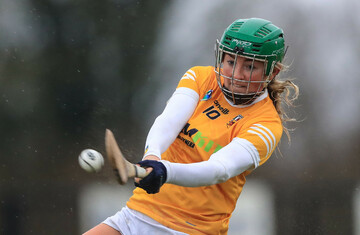ANTRIM CAMOGIE STAR Roisín McCormick says the introduction of a shoulder tackle into the sport is “a rule that needed to be changed” to improve the levels of physicality.
Six new playing rules are currently being trialled in the third-level camogie leagues, including the permission to tackle with shoulder-to-shoulder contact. This is a significant development for camogie which was previously classed as a non-contact sport.
The other rules on trial are the use of a quick puckout, taking sideline pucks from the hand inside a team’s own 45, concussion substitutes and the mark.
McCormick is studying Sports Science at TU Dublin, and her team played with these new rules in their Division 1 opener against Maynooth UNI earlier this week.
“I’m glad to see a bit more contact coming into it,” McCormick tells The42. She wasn’t playing in the match but did attend the game. “I agree with the shoulder-to-shoulder contact. It brings in a bit more intensity and physicality into the game. It’s a rule that needed to be changed as well, especially at inter-county.
“I totally agree with the puckout just to keep the game going, especially if you’re a point or two down near the end of the game. The last thing you want is to be held up over a puckout.”
There were some mistimed shoulder challenges during the TU Dublin and Maynooth game, or incidences where the challenge landed in the chest rather than the shoulder. Perfecting the tackle will take some time, says McCormick, who believes that the shoulder contact could even be implemented at a younger age grade to help with the overall transition.
“Probably minor is the right age group to bring it in. They’re a good age for it, it brings a bit more physicality. It also helps with their preparation heading into the senior grade when there is going to be stronger players and more experienced players. I know myself that I would have wanted that when I was underage.”
McCormick has mixed views about the mark. The rule that is being experimented in camogie states that a player can claim a mark if they catch their own team’s puckout from outside the 45m line and then take an indirect free.
McCormick isn’t a fan of the mark in general, but can see some instances where it can be beneficial in camogie.
“I don’t like the mark. I think it’s just bringing a Gaelic Football perspective into it. I did agree with it in football because it was very defensive, and it’s still very much in that zone. But in camogie, I wouldn’t use it myself in a match because I just want to get the ball and move it up the pitch. It breaks up the match a bit.
“It is ideal if it’s the last few minutes if you catch a puckout and take your mark. That’s a boost but I know myself I wouldn’t implement it into the game and I know a lot of camogie players find it hard to use it as well. I don’t know if it’ll be used that much.
”It’ll be good from a defensive side. If a half-back catches a puckout, there’s pressure on her straight away and taking the mark is ideal then.”
The sideline puck is an interesting development in camogie. The trial rule for this allows players to take a sideline from their hand instead of the traditional ground strike if the sideline occurs inside their own 45m line. McCormick says that there was a good execution of the amended sideline in the game between TU Dublin and Maynooth.
“I actually agree with that one. In the match the other night, I think it was used once or twice. The girls were forgetting they could use it, but it did happen once and a great ball came out of it. Obviously at this time of year, with the awful conditions, you can’t get a good sideline off.
“I think it’s good to spread out the play to take it out of your hand, hit it back to the keeper or hit it cross field. It’s good for opening up the game.”
The42 is on Instagram! Tap the button below on your phone to follow us!








Sorry but it looked like Pearson being an arsehole and taking his bad day out on someone else